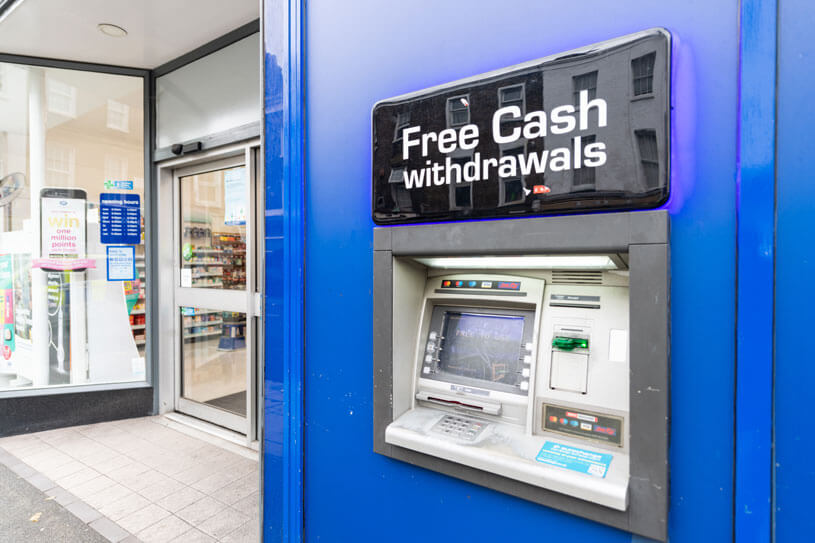With news that Santander is closing almost 100 UK branches, after Lloyds Banking Group announced the closure of 136 branches in January, we look at what to do if your bank closes.
Banks and building societies have closed over 6,000 branches since 2015, according to research from consumer champion Which? – equivalent to more than 50 each month.
This impacts access to cash for small businesses, making it more difficult and time-consuming to deposit and withdraw money.
Santander Bank branch closures
Santander has announced that it will close 95 branches across its UK network, bringing its total down to 349 from 444.
Of the branches that remain open, 36 will have reduced hours and 18 will have their front counters removed.
The Spanish bank says that it’s closing branches as more of its customers bank online.
In areas where Santander closures are taking place, customers will be served by 95 ‘community bankers’ who will visit places like libraries on a weekly basis.
Earlier this year, Lloyds Banking Group announced it would be closing 61 Lloyds branches, 61 Halifax branches, and 14 Bank of Scotland branches. These closures will reduce its network by 136 branches to 757.
Tracking UK bank closures
According to Which?’s report, some areas will be hit harder than others. More rural communities that don’t have easy access to other branches will be more affected.
Which? has a useful tool that you can use to find out whether your local bank branch is closing or has recently closed.
The guide shows the banks that have closed the most branches since 2019, as well as the most impacted areas.
You can also check which parliamentary constituencies have lost the most branches.
There are 30 entire UK constituencies without a brick and mortar bank branch, and 60 are down to their final branch. These areas have no branches left and have lost 100 per cent of their bank network:
- Bradford South
- Erith and Thamesmead
- Glasgow North East
- Liverpool, West Derby
- Nottingham East
- Sheffield, Hallam
- St Helens North
- Warrington North
- Wentworth and Dearne
How will businesses be protected against bank closures?
Organisations like Which?, UK cash machine network LINK, and the FCA are making sure that banking customers know which banks are closing branches (and when). They’re also taking steps to assess the impact of bank closures on the community.
For example, LINK reviews a community’s needs once it’s been told about a branch closure, and establishes whether a new ‘banking hubs’ could be launched there to protect access to cash. However opening these hubs has been slow going, with only 76 out of a recommended 162 having been opened as of September 2024. The government has an overall target of 350 new banking hubs by 2029.
The FCA also has created guidance for banks, setting out expectations when they’re considering either closing a branch or partially shutting down services (for example, removing ATMs). The bank should analyse:
- the needs of customers currently using the sites (including the needs of relevant small and micro businesses and customers in vulnerable circumstances)
- the likely impact of the closure or conversion, and alternatives that could continue to meet customers’ needs
What to do if your bank is closing
If your bank is closing, there’s a number of measures you can take to make sure you can still access all the banking services needed to successfully run your business.
Switch banks
If you prefer to use a bank with a real-world branch, you can use the Current Account Switching Service to safely move your banking to a new bank or building society.
This will help you move your money, standing orders, Direct Debits, and even future payments to a new account with a bank you can visit in person. Sometimes banks offer incentives for switching, like a cash bonus, and you might be able to access a higher rate of interest on savings or lower overdraft fees.
If you have a small business loan, many banks will let you use another provider to manage your business banking while continuing to manage your loan. You might have to open something called a fee-free Loan Servicing Account with your old bank while you pay off the loan.
Find out more about switching bank accounts with our full guide.
Go digital
There’s a number of brilliant banking apps that let you access most services from your phone. You can even pay into your account by cheque by taking a picture with your phone.
Some are online only, but almost all high street banks offer banking apps too. You might find that sticking with your current bank and using their banking app will allow you to do everything you need to run your business.
Check out the best small business bank accounts with banking apps.
Use the post office
Finally, you can actually pay in and take out money from most banks at the Post Office. Head to the counter and you can use your card and PIN to access services, and even pay in cheques.
More business banking guides
- Cash deposit limits on business bank accounts
- How to get a mortgage when self-employed
- The best joint business account for small businesses
- How the Bank of England base rate affects your business
Looking for self-employed insurance?
With Simply Business you can build a single self employed insurance policy combining the covers that are relevant to you. Whether it’s public liability insurance, professional indemnity or whatever else you need, we’ll run you a quick quote online, and let you decide if we’re a good fit.
